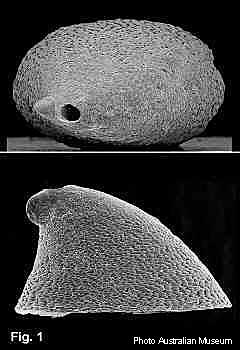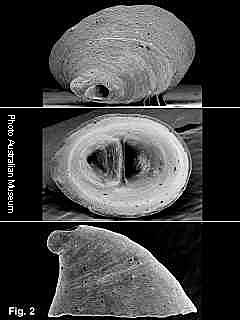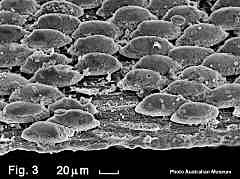|
|
|
|
|
Page not in use Space at end of page name
Puncturella kesteveni Hedley, 1900 Description: Shell tall, oval or elongate-oval, widest centrally. Apex near or overhanging posterior margin, backward pointing and recurved. Anterior slope convex, posterior slope concave. Slit at top, oval in shape. Septum internally, straight edged, occupying about one-quarter of shell height. Selenizone absent. Shell covered with a periostracum of dense scales which when removed leave a surface marked with short grooves. Occasionally with weak, broad, low folds at the margin. Periostracum scales black, fawn or white, sometimes in concentric bands. Shell white externally and internally. Size: Up to 3 mm in length. Distribution: Australia and New Zealand. In Australia, Tweed Heads, NSW, to Cape Wiles, SA. Habitat: Beach grit and down to 180 m. Moderately common. Comparison: See P. harrissoni. Synonymy: Puncturella demissa Hedley, 1904 (NEW SYNONYM); Vacerra demissa menda Iredale, 1924 (NEW SYNONYM); Vacerra menda Iredale, 1924 (NEW SYNONYM) Remarks: This remarkable shell has a periostracum of small scales, resembling the girdle of some chitons (Fig. 1). When in place the scales may be uniformly black, white, brown or in bands of these colours. When removed the shell surface is more or less white, marked with shallow pits where the scales were attached (Fig. 2). The scale detail is shown in Fig. 3. Puncturella kesteveni was described by Hedley in 1900 from a specimen with the scales missing. In 1904 he described Puncturella demissa from New Zealand from a specimen also without scales. He later recognized a Sydney specimen with scales intact as P. demissa, and Iredale in 1924 renamed that specimen as Vacerra demissa menda. Fig. 1 Watsons Bay, Sydney Harbour (C.370119) (SEM photo Sue Lindsay) Fig. 2 Collaroy Beach, NSW (C.370112) (SEM photo Sue Lindsay) Fig. 3 Watsons Bay, Sydney Harbour (C.370119) (SEM photo Sue Lindsay) |


